Volume 128 - August 2017
We will now bring you the news from Iwate's reconstruction.
National Governors Meeting held in Iwate - Adopting the Iwate Proclamation (Morioka)
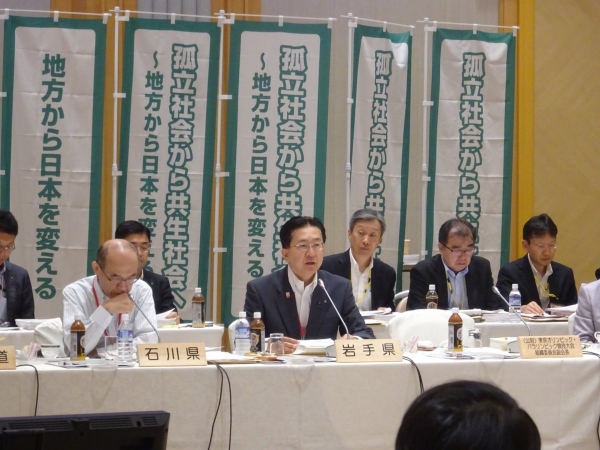
A two day National Governors Meeting was held in Morioka City on July 27 (Thu) to 28 (Fri). This is the first time for the meeting to be held in one of the three disaster-affected prefectures (Iwate, Miyagi, Fukushima) since the Great East Japan Earthquake and Tsunami.
In his opening statement, Governor Tasso said, “The driving force of Iwate’s reconstruction is the power of our relationships with the rest of Japan and the world, and also the fundamental strength of the local people. We would like to express our appreciation by showing you how our reconstruction has progressed.”
The meeting’s discussion covered eight themes / 22 topics with the title “From Isolation to Coexistence ~ Changing Japan’s Society from the Regions outside Tokyo” as its main proposition. Topics such as a swift recovery from the Great East Japan Earthquake and Tsunami, the Tokyo Olympic and Paralympic games, and the development of the regions outside Tokyo were compiled to propose to the national government.
On the 27th, an “Iwate Proclamation” was adopted in which the national and the local government will cooperate together to work on its goals of continuing humanitarian aid, ensuring long term funding for the reconstruction, enriching disaster education for future generations, and building a disaster-resistant country.
The meeting ended in the morning of the 28th, and the governors were divided into three groups to visit the coastal disaster-affected areas.
At the press conference in the end, Governor Tasso said, “With the Iwate Proclamation adopted, a strong message regarding the nation’s recovery and disaster has spread out across the country. I think this is a big step to change Japan from within the local regions.”
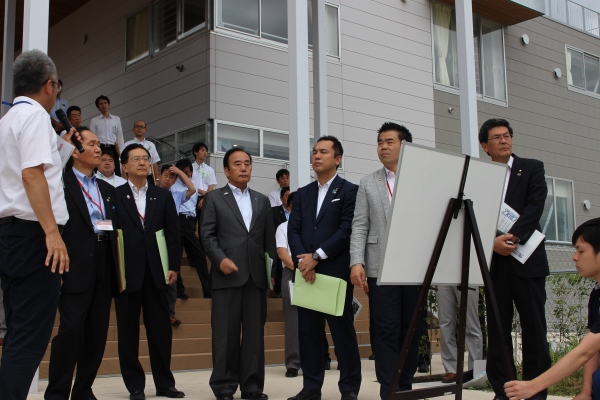
In Hopes of a Full Reconstruction - Ring Entrance Ceremony by Kisenosato & Harumafuji (Kamaishi)

On August 14 (Mon), Yokozuna-rank sumo wrestlers, Kisenosato (from the Tagonoura stable) and Harumafuji (from the Isegahama stable), performed their ring entrance ceremony (dohyo-iri) in hopes of a full reconstruction from the Great East Japan Earthquake and Tsunami at the shared gymnasium of Unosumai Elementary School and Kamaishi Higashi Middle School in Kamaishi City.
This ceremony performed by the yokozuna sumo wrestlers is one of many support activities to assist the disaster-affected areas, and has continued for seven years straight since 2011.
After a moment of silence by all attendees, both yokozunas together with program chief assistant Tamanoi offered memorial flowers to the victims, then performed drum demonstrations and a sumo-themed song (sumo jinku).
With Iwate native Makuuchi-rank sumo wrestler, Nishikigi, as his forerunner, and similarly, Kagayaki, as his sword bearer, Kisenosato demonstrated a powerful Unryu-style ring entrance. Afterwards, Harumafuji demonstrated a Shiranui-style entrance. Both performances were enjoyed by the audiences (about 1,000) that came to see them.
Kisenosato said, “Even if it’s only for a little while, I want to support the survivors by making them happy. I want to return home with my mind and body toughened up (through this experience), and display a good example of sumo wrestling.”
We are recruiting members for the Iwate Reconstruction Supporters Team!

Know, Buy, Eat, Go - and Help Support Us!
Free to Register!
We are now recruiting both individual and group (corporate or other) members in the Greater Tokyo Area for the “Iwate Reconstruction Supporters”. Members are e-mailed information regarding reconstruction and tourism in Iwate, and upcoming events in the Tokyo area. (Information only available in Japanese.)
For more information, please see the website of the Tokyo Branch Office of the Iwate Prefectural Government:
Reconstruction of the Miyako Athletic Park
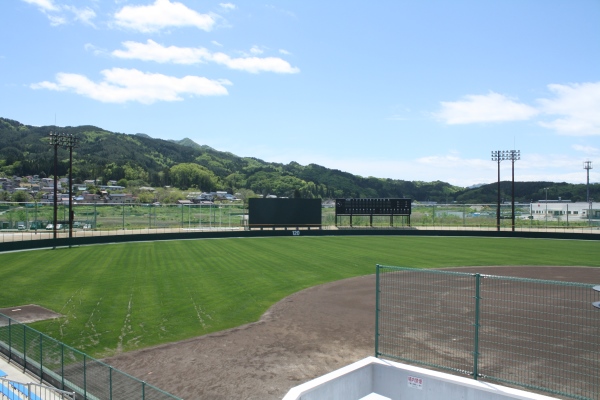
On July 12 (Wed), an inauguration ceremony was held to commemorate the completion of the reconstructed Miyako Athletic Park, which was completely destroyed in the Great East Japan Earthquake and Tsunami.
The total area of the park is 16.1 hectares including a baseball field, track-and-field area, a multipurpose square, and a free space area. The baseball field was rebuilt the way it was before the disaster, with 1,268 seats for the back stand and 648 seats for the infield area totaling 1,916 seats.
Also, in addition to the 8-lane 400m weatherproof tracks of the track-and-field area, a 4-lane 50m indoor practice area has been built. This makes it the coastal regions’ first to be a Class 3 Certified field to hold a prefectural level competition.
On July 29 (Sat), to commemorate the renewal of the park, the baseball field was used to host the Tohoku Rakuten Eagles vs Yokohama DeNa match of the Eastern League Professional Baseball Competition. Additionally, on the 30th (Sun), track-and-field classes were held by the runners of the Mizuno Track Club (a prestigious athletic club). With the park’s completion, there are high hopes of revitalizing the local area through sports.
The Long-Awaited Public Library Opens! (Rikuzentakata)

On July 20 (Thu), the public library of Rikuzentakata City, which was completely destroyed by the Great East Japan Earthquake and Tsunami, was opened after being rebuilt on raised land in the central city area.
The new library is adjoined to Abasse Takata, a large shopping center, and is a wooden structure with a floor space of 900m². Different types of wood were used to give a warm and spacious feel, such as the locally obtained Japanese Larch for its pillars, a generous amount of Kesen Cedar used on its floors, and an outdoor wooden terrace deck for reading.
The facility holds 65,000 books, 4,500 DVD & CDs, and 100 types of magazines. In order for it to be welcoming to as many people as possible, a kids corner (complete with a nursing room and a family bathroom) and a study space for middle / high school students has been constructed.
The opening of the library, along with Abasse Takata, is expected to be a major leisure spot for the public and revive the liveliness of the city.
Feature

What happened that day? In this section, we will be looking back at the disaster in each coastal town.
Kamaishi City
- Height of Tsunami: 15.1m Otsuchi Bay/ 22.6m Ryoishi Bay/ 10.1m Kamaishi Bay/ 21.0m Touni Bay
- Deaths 888
- Missing 152
- Injured Unknown
- Destroyed Buildings 3,655
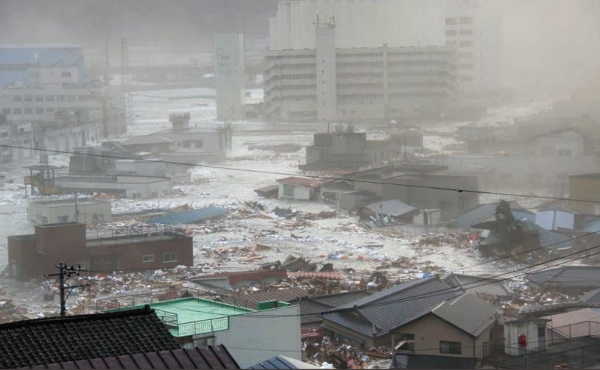
The Unosumai area suffered the most damage
In Unosumai, the worst-hit area of the city, the tsunami obliterated about 500m of tidal walls and flowed into the city center. The area by itself suffered more than one-third of the flooding recorded for the entire city, with 266 hectares of flooded areas.

Damages to the city center and east area of Kamaishi
The tsunami hit the city center (east of Kamaishi Station) and the waves ran up the Kasshi River that flows through the city for about 3.5km. The city hall and the fire station, which served as bases of operations during the disaster, suffered flooding, and fishing equipment and facilities along the harbor received extensive damage as well.
Seven Years On: Two beaches are reopened on the Sanriku Coast (Ofunato, Yamada)

On July 22 (Sat), the Uranohama Beach in Yamada Town and Okirai Namiita Beach in Ofunato City reopened seven years after the deep scars left by the Great East Japan Earthquake and Tsunami.
- Uranohama Beach (Yamada Town)
Two-thirds of the sandy beach had been lost by the tsunami. With reconstruction grants from the national government, 27,000 tons of sand were brought from out of the prefecture to rebuild the beach as the prefecture’s first artificial sand beach. The beach office, also swept away by the tsunami, has been rebuilt with 8 shower rooms (male/female) added. - Okirai Namiita Beach (Ofunato City)
Ofunato City has been aiming to open three of its beaches since the disaster, and the Okirai Namiita Beach is the first to reopen upon completion of reconstruction efforts.
There may have not been good weather this season, but there are hopes for it to be a popular summer leisure destination for the Sanriku in the future.
Seven years since the last Yoichi summer festival (Otsuchi)
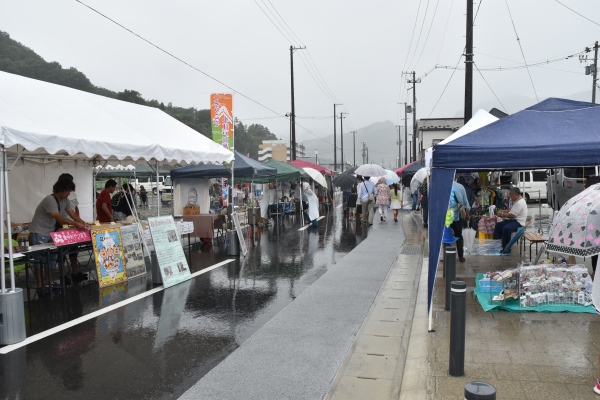
On August 12 (Sat), the Yoichi summer festival, hosted by the Otsuchi Suehirocho Shopping District Co-op Association, was held in the Machikata district in Otsuchi Town. It was the first since the disaster after the town was heavily damaged by the tsunami.
As work toward reconstruction progressed, shop owners who had reopened their shops (and those planning to) gathered to revive the Yoichi, Otsuchi’s summer highlight, to reenergize the city. At the opening ceremony, Representative Director Kikuchi of the aforementioned association said, “As a step toward the rebirth of the town’s central area, we would like you to enjoy a moment of summer here.”
At Yoichi, there were about 30 shops on the Suehirocho-dori (street) where the shopping district once was. Support workers were dispatched, and booths were up selling local specialty items and promoting tourist destinations. Events such as mochimaki (scattering rice cakes), traditional folk arts, and traditional Japanese songs were performed at the main stage. Although it rained the whole day, the townspeople and those returning for obon season enjoyed the long-missed Yoichi festival.
Explore Sanriku! The Whale & Ocean Science Museum Reopens! (Yamada)

The Whale & Ocean Science Museum in Yamada, a popular tourist spot, has reopened and since then has been visited by many tourists. The impressive real-life scale model of a sperm whale hanging from the museum's ceiling is a must-see!
The Whale & Ocean Science Museum, opened in 1992 to showcase Yamada Town's history of its successful whaling industry, suffered flooding of up to 5m high in the Great East Japan Earthquake & Tsunami. Although many of the museum's stored documents and materials were swept away, the museum was able to restore some of the materials and reopen on July 15 (Sat).
The museum provides various fun features such as a special exhibition room with a 17.6m long skeletal model of a sperm whale, a popular 3-D film featuring the ocean as a life form, and other limited-time only events. Visitors can closely experience the rich Sanriku culture of ocean life at this museum.
Address: Iwate Prefecture Shimoheigun Yamadacho Funakoshi 7-50-1
Hours: 9:00〜17:00 (Last entry by 16:30)
Holidays:
- Every Tuesday (If the day lands on a holiday, the next weekday is observed)
- New Year’s holiday
- Inventory dates (12/1〜12/10)
Fees:
- Elementary/Middle 150yen
- High school/University 200yen
- General 300yen
Inquiries: Whale & Ocean Science Museum, Phone:0193-84-3985
Feature

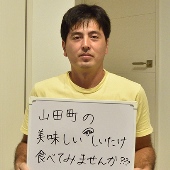
Many young people are diligently helping the affected area of Sanriku move toward a full reconstruction. The section “People for Sanriku’s Future” introduces these young people and their powerful feelings.
Click the link to read about Takashi Haga and how he grows shiitake mushrooms in Yamada Town.
Casualties and Damage in Iwate (as of July 31, 2017)
- Deaths: (direct) 4,672, (indirect) 463; Missing: 1,121
- Buildings destroyed (residences only, total/partial): 26,077
Thank you for all of your support! (as of July 31, 2017)
Donations for survivors: Around 18.56853 billion yen (94,951 donations)
Donations for reconstruction projects: Around 19.84621 billion yen (8,260 donations)
Iwate Learning Hope Fund donations: Around 9.02510 billion yen (20,336 donations)
※ This fund is to assist in the study and daily life of affected
children by encouraging sport and study activities.
Contact
News from Iwate’s Reconstruction, Volume 128. August 5th, 2017.
Published by the General Affairs Division, Bureau of Reconstruction, Iwate Prefecture.
Phone: 019-629-6925
Editing & Printing: SYNAPSE
*News from Iwate's Reconstruction Volume 129 will be published on September 25, 2017.
PDFファイルをご覧いただくには、「Adobe(R) Reader(R)」が必要です。お持ちでない方はアドビシステムズ社のサイト(新しいウィンドウ)からダウンロード(無料)してください。
このページに関するお問い合わせ
Office of International Affairs, Department of Homeland Promotion
(020-8570) 10-1 Uchimaru, Morioka City, Iwate Prefecture, JAPAN
Phone number:019-629-5765 Facsimile:019-629-5254
You can access our question form here.

